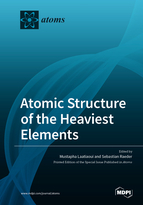Atomic Structure of the Heaviest Elements
A special issue of Atoms (ISSN 2218-2004).
Deadline for manuscript submissions: closed (30 April 2022) | Viewed by 33632
Special Issue Editors
Interests: superheavy elements; laser spectroscopy; ion mobility spectrometry
Special Issue Information
Dear Colleagues,
Actinides exhibit a remarkable transition in terms of applied and fundamental research as they comprise the heaviest naturally occurring as well as fully manmade chemical elements. They have attracted the attention of atomic spectroscopists since their discovery as it was believed that many of their elemental properties could be deduced from knowledge of the electron configuration. The tiny quantity production of these elements did not prevent scientists from performing elaborate and extensive spectroscopy, such as with huge spectrographs. Thus, essential data about the atomic structure up to element 99 – einsteinium – were obtained even if some spectral lines could not be (or not correctly) assigned back then.
Today, we are much further along in atomic spectroscopy, although the actinides are far from being fully explored. In addition to better model descriptions of the atom, recent developments and advances in the field of optical spectroscopy have not only led to a better understanding of the atomic structure of the already measured elements but also to tackling the superheavy elements previously considered experimentally inaccessible.
This Special Issue of Atoms covers recent theoretical and experimental work about the atomic structure of actinides as well as related topics, such as transport properties in gases, nuclear properties, and medical applications. With the advancing technology for production and handling of actinides and transactinides, we hope that this issue will serve as a useful resource for future work in the field of optical spectroscopy and accelerator-based laser ion sources. We welcome original research articles as well as review articles on specific topics.
Dr. Mustapha Laatiaoui
Dr. Sebastian Raeder
Guest Editors
Manuscript Submission Information
Manuscripts should be submitted online at www.mdpi.com by registering and logging in to this website. Once you are registered, click here to go to the submission form. Manuscripts can be submitted until the deadline. All submissions that pass pre-check are peer-reviewed. Accepted papers will be published continuously in the journal (as soon as accepted) and will be listed together on the special issue website. Research articles, review articles as well as short communications are invited. For planned papers, a title and short abstract (about 100 words) can be sent to the Editorial Office for announcement on this website.
Submitted manuscripts should not have been published previously, nor be under consideration for publication elsewhere (except conference proceedings papers). All manuscripts are thoroughly refereed through a single-blind peer-review process. A guide for authors and other relevant information for submission of manuscripts is available on the Instructions for Authors page. Atoms is an international peer-reviewed open access monthly journal published by MDPI.
Please visit the Instructions for Authors page before submitting a manuscript. The Article Processing Charge (APC) for publication in this open access journal is 1500 CHF (Swiss Francs). Submitted papers should be well formatted and use good English. Authors may use MDPI's English editing service prior to publication or during author revisions.
Keywords
- optical spectroscopy
- actinides
- transactinides
- superheavy elements
- transport properties
- atomic structure
- electronic configuration
- ion–atom interaction
- relativistic effects
- electron correlations






